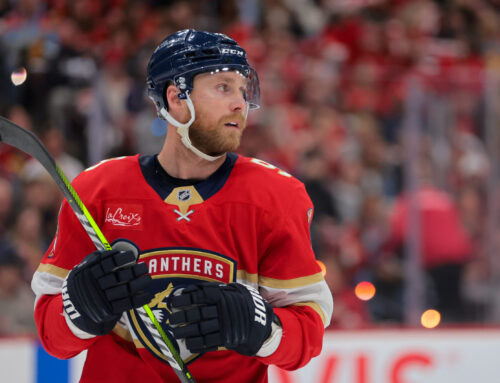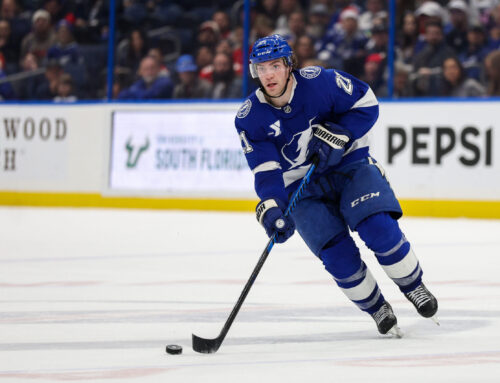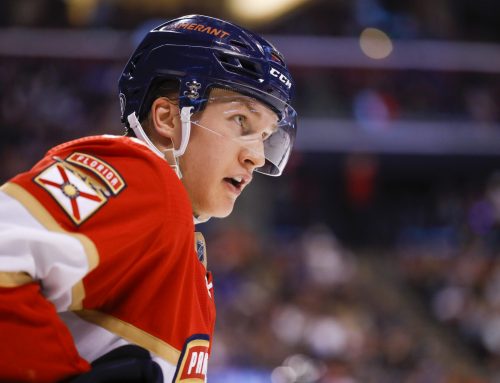
This week’s battle is between Mark Stone and Mikael Granlund. For Stone, 2016-17 could be his third straight 61-65 point season, while for Granlund it would represent the first time he’s bested even 44 points. Does Stone have another gear, or has he peaked? Is Granlund breaking out, or is his 2016-17 production entirely – or at least partially – the result of unsustainable good luck? Cage Match is here to give poolies the answers to these all-important questions.
Career Path and Contract Status
Stone, 24, was drafted 178th overall in 2010 after two unremarkable WHL seasons; but upon returning to juniors for his age 18 and 19 seasons, he exploded with 229 points in 137 games. Despite that success, Stone had to prove himself over the next two years in the AHL (79 points in 91 games) before finally landing with the Sens to stay in 2014-15. Since then, he’s been among the more consistent under 25 players, with 64 points in his first full season and 61 in 2015-16. He’s producing similarly well for 2016-17 (62 point pace), making poolies happy but also raising concern as to whether he’s capable of 65-70+ points.
Granlund, also 24, was selected 169 spots earlier in the same 2010 draft. Following two more seasons in Finland (84 games, 87 points) Granlund came stateside. After 28 points in 29 AHL games and a brief NHL stint in 2012-13, Granlund was a full time NHLer for 2013-14. He has since entered each campaign amid expectations that he’ll break out; yet his scoring pace has dropped each season – from 53 (2013-14), to 47 (2014-15), to 44 (2015-16), leaving many to wonder if he’d ever take that next step. Then, during the 2015 IIHF World Championships he lined up at wing alongside Mikko Koivu and produced better than point per game scoring. That opened the eyes of Minnesota to use him in a similar role, where he’s thrived and enters the all-star break with just two fewer points than his previous career high.
Stone is signed through 2017-18 for a $3.5M yearly cap hit, while Granlund’s emergence is particularly (or some might say, suspiciously) well timed since this is the last season of his $3M per year deal.
Ice Time
Stone’s 2013-14 data isn’t charted in this or other tables because he only played 19 games.
|
Season |
Total Ice Time per game (rank among team’s forwards) |
PP Ice Time per game (rank among team’s forwards) |
SH Ice Time per game (rank among team’s forwards) |
|
2016-17 |
18:43 (M.S.) – 2nd 19:06 (M.G.) – 2nd |
3:11 (M.S.) – 2nd 2:07 (M.G.) – 5th |
0:04 (M.S.) – 9th 1:40 (M.G.) – 2nd |
|
2015-16 |
20:06 (M.S.) – 1st 18:08 (M.G.) – 3rd |
2:59 (M.S.) – 2nd 2:37 (M.G.) – 3rd |
1:13 (M.S.) – 7th 0:34 (M.G.) – 7th |
|
2014-15 |
17:01 (M.S.) – 3rd 17:53 (M.G.) – 4th |
2:23 (M.S.) – 5th 2:09 (M.G.) – 5th |
1:23 (M.S.) – 5th 0:26 (M.G.) – 10th |
|
2013-14 |
17:19 (M.G.) – 4th |
2:32 (M.G.) – 6th (tied) |
0:28 (M.G.) – 10th |
Granlund’s jump in Total Ice Time this season has come almost entirely from undesirable SH Time, while also shedding nearly 20% PP Time compared to 2015-16. Thus, Granlund’s huge leap in production rate has occurred despite him actually averaging less non-shorthanded Ice Time compared to 2015-16 (when he scored only 44 total points) and less PP Time than either last season or 2014-15 (when he had a 47 point full season scoring pace). Somewhat balancing out those concerns is the fact that Granlund is still only 24 years old and this being his magical fourth year; however, we’ll have to pay close attention to luck metrics to determine whether this is at all sustainable.
Stone’s SH Ice Time situation is essentially the opposite of Granlund’s, in that Stone’s drop in Total Ice Time from 2015-16 to 2016-17 has occurred due to shedding nearly all his previous SH Ice Time. The net result is Stone’s non-shorthanded Ice Time being barely changed from 2015-16, coupled with a small gain in PP Time. But the news might not be entirely good for Stone, as although of course poolies would be happy with the consistency of him being able to finish his third straight season with 60-65 points, it’s likely below what they’d hoped for by now.
So where can Stone realistically go from here? Maybe nowhere, as normally when a player has a fourth year breakout, he’s younger than 25 and has more of an upward trajectory. There’s also the fact that since 1990-91 only two forwards scored 60-70 points in three separate seasons while aged 21-25 (Geoff Sanderson, Jeff O’Neill) and neither tallied 70+ points in a season after age 25.
Of course there is another way for Stone’s stats to improve – he produces at the same rate but gets additional Ice Time. That’s not entirely unrealistic, since in the past three seasons there’ve been 51 instances of forwards posting 70+ points; Stone’s 18:43 per game for 2016-17 is less than the average Ice Time of all but 11, with 33 receiving 0:30+ per game more than what Stone averages now.
That, plus Stone’s newfound lack of SH duty, suggests there’s room for him to hit 70+ in the future; however, the big question is whether Ottawa coach Guy Boucher will actually play Stone more. We know Boucher played Martin St. Louis and Steven Stamkos 20:00+ per game each season he coached in Tampa. Therefore, although we can’t know for sure whether Boucher has rethought his past approach to allocating Ice Time, he was previously willing to play certain forwards enough to give them a better chance at 70+ points, as opposed to being a coach (like, say, Alain Vigneault or Claude Julien) who’s consistently spread Ice Time evenly among the top six/nine.
Secondary Categories
|
Season |
PIMs (per game) |
Hits (per game) |
Blocked Shots (per game) |
Shots (per game) |
PP Points (per game) |
|
0.37 (M.S.) 0.12 (M.G.) |
0.58 (M.S.) 0.56 (M.G.) |
0.82 (M.S.) 0.66 (M.G.) |
1.82 (M.S.) 2.10 (M.G.) |
0.24 (M.S.) 0.25 (M.G.) |
|
|
2015-16 |
0.50 (M.S.) 0.24 (M.G.) |
0.73 (M.S.) 1.05 (M.G.) |
0.72 (M.S.) 0.69 (M.G.) |
2.01 (M.S.) 1.95 (M.G.) |
0.20 (M.S.) 0.13 (M.G.) |
|
2014-15 |
0.17 (M.S.) 0.29 (M.G.)
📢 advertisement:
|
0.61 (M.S.) 0.69 (M.G.) |
0.66 (M.S.) 0.66 (M.G.) |
1.96 (M.S.) 1.45 (M.G.) |
0.16 (M.S.) 0.11 (M.G.) |
|
2013-14 |
0.35 (M.G.) |
0.60 (M.G.) |
0.71 (M.G.) |
1.60 (M.G.) |
0.17 (M.G.) |
Neither is a multi-cat asset, with only Stone having ever posted a combined two PIM+Hits+BS, and doing so just once (2015-16). Beyond that, both players aren’t high volume shooters; and before this season, neither had tallied more than one PPPt per every five games in any campaign.
What do their low SOG and PPPt rates mean for their production now, and down the road? While it’s reasonable to say that with rates this low there’s room for growth (which, in turn, should make it easier for them to increase production), these aren’t 20 year olds or NHL newbies. Their low SOG rates are particularly concerning. After all according to nhl.com in the past five full seasons there’ve been 43 instances of wingers who scored 70+ points in a season. Of those 43, only three had fewer than 2.3 SOG per game in their 70+ campaign – Loui Erkisson and Ray Whitney in 2011-12, and Jiri Hudler in 2015-16. Eriksson has only one campaign with more than 47 points since then, Whitney retired after his next full season (32 points in 69 games), and Hudler had a mere 46 points in 72 games last season.
Stone did enter the all-star break with 24 SOG in his last seven games (3.42 per game rate) and Granlund with 25 (i.e., 3.57 per game). But here’s the thing – both players had stretches of 23 SOG in seven games last season, so this isn’t uncharted territory. Long story short – unless Stone or Granlund finds a way to shoot more and on a consistent basis, neither one is seemingly a good bet to top 70 points in a season. Or if they somehow manage to do so, it could be a “one and done” situation ala what happened with Eriksson, Whitney, and Hudler.
Luck-Based Metrics
|
Season |
Personal Shooting Percentage |
Team Shooting % (5×5) |
IPP (5×5) |
IPP (5×4) |
Offensive Zone Starting % (5×5) |
|
2016-17 |
19.0% (M.S.) 11.9% (M.G.) |
8.86% (M.S.) 11.64% (M.G.) |
67.7% (M.S.) 62.2% (M.G.) |
57.9% (M.S.) 75.0% (M.G.) |
53.0% (M.S.) 36.9% (M.G.) |
|
2015-16 |
15.2% (M.S.) 8.1% (M.G.) |
8.0% (M.S.) 5.7% (M.G.) |
73.9% (M.S.) 75.8% (M.G.) |
57.7% (M.S.) 52.4% (M.G.) |
51.9% (M.S.) 59.4% (M.G.) |
|
2014-15 |
16.6% (M.S.) 8.1% (M.G.) |
10.4% (M.S.) 9.0% (M.G.) |
79.6% (M.S.) 58.0% (M.G.) |
56.5% (M.S.) 54.5% (M.G.) |
52.3% (M.S.) 60.1% (M.G.) |
|
2013-14 |
7.9% (M.G.) |
8.5% (M.G.) |
83.3% (M.G.) |
58.8% (M.G.) |
53.1% (M.G.) |
For Granlund, there are 2016-17 red flags nearly everywhere. First and foremost, his 36.9% OZ% is incredibly low. Of the 290 forwards who played 60+ games last season, only 12 had an OZ% lower than 38%. Care to guess what the highest point total among the 12 was? Try 43, by J.G. Pageau, with none of the other 11 besting even 34 points.
If that wasn’t concerning enough, there’s Granlund’s 11.64% Team Shooting Percentage. The normal average for forwards is about 9.00%; and Jaromir Jagr in 2015-16 is the only forward in either of the last two seasons to play more than 65 games and finish with a higher Team Shooting % than 11.5%. There’s also Granlund’s 5×4 IPP for 2016-17 being well above his normal rate of 50-55%, although, in fairness, his 5×5 IPP is only 62.2% after having been over 75% in two of the past three seasons, so chances are whatever benefit he’s receiving from his 5×4 IPP being unsustainably high is somewhat balanced out by his 5×5 IPP being a bit lower than normal. All in all, Granlund’s data paints a gloomy picture not only for his production during the remainder of 2016-17, but very much casts doubt upon him being more than 60-65 point player going forward.
The news for Stone is somewhat better. Sure – his Personal Shooting % is high; however, we can see from his past two seasons that he runs high in general. Plus, his Team Shooting % is right at average. So although he might be getting more goals than he deserves, the overall scoring at 5×5 while he’s on the ice isn’t unsustainably high.
Also, Stone’s 5×5 IPP is below 70% for the first time, so chances are that will be boosted before all is said and done for 2016-17. His history of 70%+ IPP at 5×5 also supports the idea that if he gets more Ice Time he’ll see his points total rise, since the kind of player who, year after year, can factor into 70%+ of points scored while he’s on the ice at 5×5 is exactly who can meaningfully benefit on the score sheet from more Ice Time.
Stone’s other two metrics – 5×5 IPP, OZ% – are stable, and further examples of areas which seemingly have room to improve enough to get him into 70+ point territory. Yet we still have to wonder if – due to how consistent all hisnumbers have been – he might be showing us his ceiling already, as opposed to room to grow further.
Who Wins?
It’s a clean sweep for Stone – he wins in one-year and keeper leagues. Not only are there more red flags with Granlund, but they’re serious ones. Plus, Granlund’s major jump in production has led to vastly increased fantasy attention; and with that comes inflated cost. In contrast, Stone’s “steady eddie” production has, if anything, caused perceived disappointment and his cost to stay lower than it should.
Granlund is a very tempting sell high. No need to panic and take the first deal you can get; however, you should look for an excuse to deal Granlund sooner rather than later. Stone is likely a hold; although he might not ultimately get to 70+ points this season or in the future, he’s still someone whom poolies can count on to produce. And in fantasy hockey, that’s exactly what you want for your team.
8 Comments
Leave A Comment
You must be logged in to post a comment.





 EDM
EDM STL
STL ANA
ANA BUF
BUF DET
DET NYI
NYI CAR
CAR MIN
MIN PIT
PIT CBJ
CBJ

I’ve always gotten the impression that you (not just you but the other contributors here at Dobber) have just never really cared for Granlund. I’ve read all season how he is going to come back to earth, slow down, tail off. And yet here we are in February and he has points in 10 straight games and 17 of 20. He also has 29 points over his last 26 games. Sometimes the analytics don’t tell the whole story. Sometimes guys just find ways to produce. I’ll take Granlund over Stone this year. I’m not in a league where we protect a ton of guys so the future past this year means nothing to me with these two (we protect 3 guys in our league….I have Benn, Panarin, Drouin, Voracek and maybe Rask to think about) so even if I had both I couldn’t protect them. Minnesota has been scoring this year and Granlund is playing well. So for me, in a one year approach, I’ll take Granlunds terrific 2016-17 campaign and run with it.
I quietly shopped Granlund the summer of 2015. Got no bites. The summer of 2016 I was more aggressive in shopping him. Still no bites. I just want to thank those owners for backing away from my trade offers. Happy to keep him now!
But I’d still trade him for Stone in a heartbeat. Similar upside, and Stone has proven track record – especially in the second half when he really surges.
If only that was true about not caring for him. I actually owned him in my major money league for three straight seasons…..until this one. As for his 2016-17 campaign, sure the analytics can be wrong, but not normally when they’re stacked so much against someone like they are here. Players can produce point per game numbers for a third of the season yet still score only 60 points. It happens all the time. While Granlund clearly has taken an important step forward, what the numbers showed here is we should pump the brakes before calling him more than a 60 point player going forward.
I chose him in the first round (sixth overall) in my main keeper pool in 2011. I was very high on him. Eventually traded him about three years later to help me win the championship, but everyone was shocked I got rid of him at all.
The fact that he produced 43 pts in 49 games despite very low OZ%, doesn’t that show that he’s the real deal? Or simply that he’s “lucky”?
This is a fair point, and one that was raised in the forums as well. While of course it’s worthy of praise for him to have posted such good stats despite such a low OZ%, it’s not sustainable based on all sorts of past results. Of course it does beg the question of whether he’d do even better if his OZ% was higher. While I’d say it’s true that more ice time usually translates to more points, I’m not sure the same is true with OZ since Granlund’s ice time would likely be similar. A higher OZ% also likely would lead to Granlund having more defensively capable forwards from the other team lining up against him. Last, but certainly not least, a lot of Granlund’s success despite his OZ% being so low is due to his unsustainable good luck from his other metrics. Take those away – and they likely will go away over time – and the effect of the low OZ% will be more pronounced.
Granlund P/60 as gone up every single season he had played with the wild just saying. Also his line his one the best possesion lines in the league. Just saying.
Correct me if I’m wrong but it appears that Stone faces lesser opponents based on is QoC as opposed to Granlund whose average QoC was around .698. Also if we’re talking year-to-year, Granlund had a very low PDO through 2015-16 (however it is quite high this season). The high dZS% is actually encouraging, however, as it says that he is moving play up the ice that is achieving results.